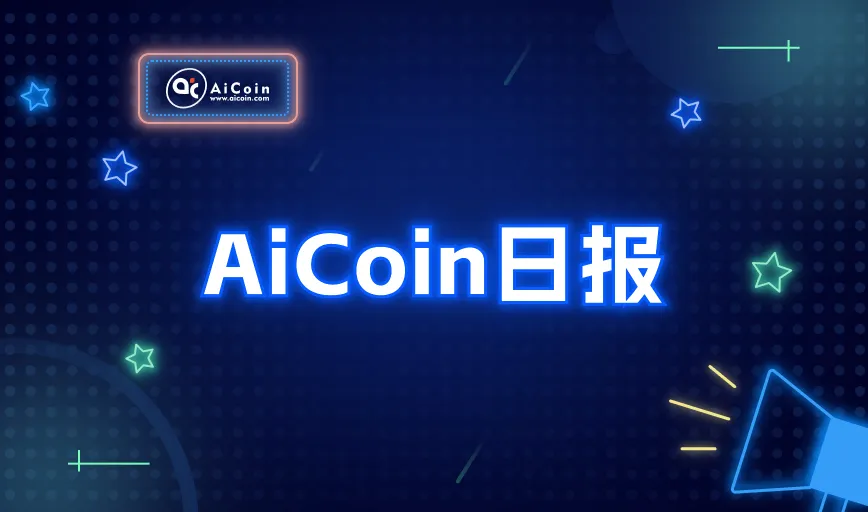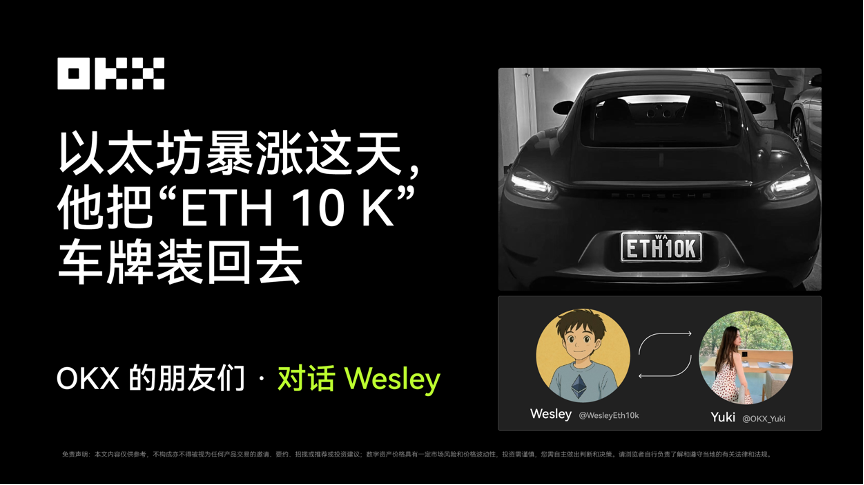
The moment the red taillights lit up, Wesley reattached the license plate that read ETH 10 K. He smiled and said, “Cars can be bought again, positions can be added again, but face must be regained first.”
After the Spring Festival, ETH fell and the market was filled with predictions of “seeing 800 dollars.” He sold all three cars: a Ferrari used for buying Coke, an SUV for grocery shopping, and a red Porsche with the license plate “ETH 10 K,” even letting go of the license plate. He also sold two properties in Australia, went to a farm to pick fruits, did physical labor during the day, and self-studied coding at night, working for several project teams.
On August 11, the day ETH returned to 4350 USD, he didn’t rush to increase his position or change cars; the first thing he did was redeem the license plate. He said that this small metal plate was a way to account for his past self.
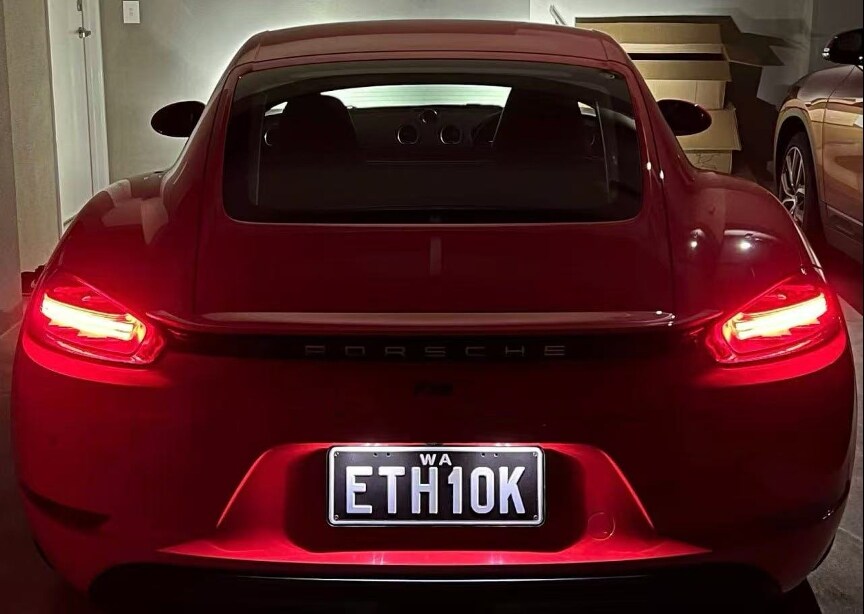
In the interview room at OKX, I sat across from him. He didn’t look like a traditional “trader,” but more like an engineer. He spoke logically, didn’t chase trendy terms, and preferred to start from “verifiable” points.
“I won’t sell; I have no intention of selling. After it rises to 10,000, I will put ETH into Aave/Compound, borrow a bit of USDT out, and still won’t sell. Even if there’s a pullback, it doesn’t matter, just low leverage is fine.”
He said “I won’t sell” calmly, as if completing a task that needed to be done.
From 2015 to 2025: A winding yet clear line
2015—2016, Hong Kong Investment Bank → Entrepreneurship (Chatbot Lending MVP)
Wesley graduated from the finance department and received a full-time offer in Hong Kong, working as a bond salesman for two years. “Working felt like acting; I’m more introverted, so I resigned and went home to start a business.”
His first “product” was neither an app nor a website, but a chatbot built using the Facebook SDK—a network lending system aimed at students. “To be honest, I had only been coding for a month or two and couldn’t create a complete app or website. The easiest way for me was to write the logic into the SDK and guide users through text.” At that time, there was no ChatGPT or LLM; he used conditional statements to parse keywords, breaking down the loan process into executable dialogues, thus completing a rough but functional MVP.
After launching, due to the minimal team (basically just him and a partner), the product logic was simple, and they broke even in two to three months; the total transaction volume was about 10 million, serving five to six hundred users.
“My motivation to start a business was simple: my family was poor, and I wanted to study abroad but couldn’t afford the tuition.” He rented a place in Wan Chai, paying a deposit and two months’ rent upfront, with the deposit alone being 26,000 HKD. The bank wouldn’t lend, and the landlord wouldn’t accept credit cards, so he had to gather money from several friends to settle in. “At that moment, I thought, can there be a more dignified way for students like me? Uploading a student ID and scholarship records to get a small loan?” Among the first borrowers, there were students who used the money to buy tickets to Japan and repaid it as soon as they landed. Fortunately, there were no bad debts. The amounts were small, but surprisingly stable.
Later, after arguing with his partner, he was forced to learn coding on his own, “or the company would fail.” Soon, the company was sold, and he pocketed his first original accumulation.
2016—2017, Australia Working Holiday: Daytime Financial Analysis, Nighttime Self-Studying Code
After wrapping up his entrepreneurial project in 2016, he had the idea to go to Australia for a working holiday. To obtain residency, he first went to study, but since his undergraduate degree was in finance, he had to work in finance-related jobs.
During the day, he worked at a very small community bank, where his daily tasks even included counting the cash in and out of ATMs. Once, a bizarre case emerged: a gangster from South Africa tampered with the cash transport armored vehicle, underloading the ATMs by a little each time, stealing 7 million over the year. The bank was a publicly listed company, ultimately covered by insurance, but his position was affected. Later, the bank faced a hostile takeover, and he was transferred to financial analysis: equity valuation, merger models, Excel reports—solid processes, but the pace was slow, with colleagues leaving work by three or four in the afternoon.
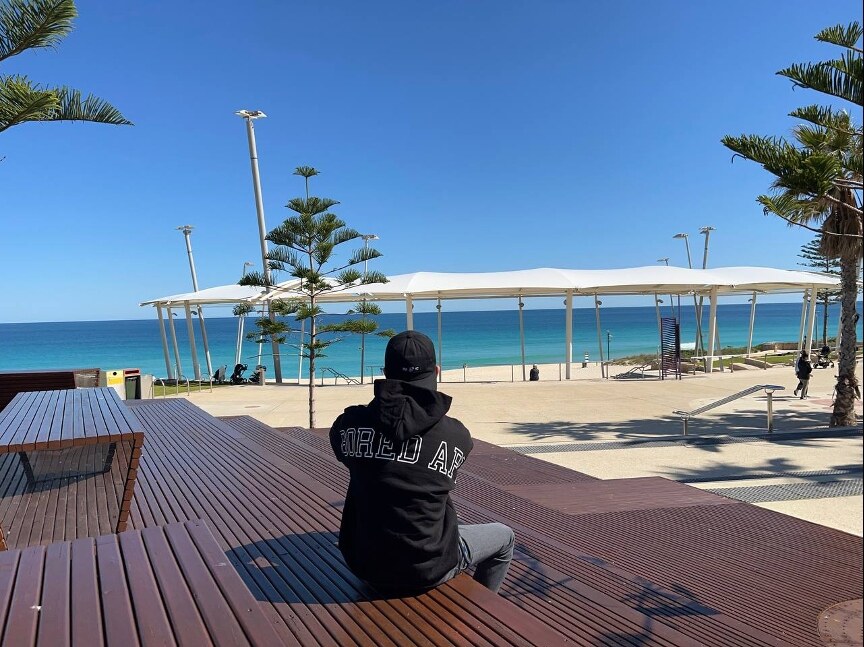
After evening, he dedicated all his “blank time” to programming: finding online courses to learn, watching open classes and PDF textbooks, filling in data structures, algorithms, and operating systems; at the same time, he prepared for GRE/TOEFL, planning a path of “going to the US for a master’s → obtaining OPT → entering a big company.”
Reality was not glamorous: having only coded for a year and lacking systematic training, his resumes were repeatedly rejected. To maintain his Australian residency, he briefly took finance-related courses, but ended up back in his old field. After two years, he saved about 400,000 RMB in Australia and became increasingly certain—if he really wanted to code, he had to return to the Chinese community and solidify his path as an engineer. So he chose to return, officially shifting to the engineering track, laying the foundation for his later entry into Web 3.
2018—2019, Australia → Return
In the photos Wesley shared with us, two were of cars, and another was of the sea in Australia, with the wind blowing across the wide shore. As for the following “room photo,” it was not taken in Australia but in a small place he rented after returning home; the room was not big but very bright.
“The view is nice, and many friends are willing to come over,” he said with a smile.

After returning to the Chinese community, Wesley joined a Hong Kong insurance startup as a backend engineer. At that time, a cryptocurrency exchange collapsed, leaving around eighty to ninety practitioners unemployed, and the company hired many people at once, “the language in the office suddenly turned into crypto jargon.” Thus, he officially entered the circle.
In 2019, he began to allocate ETH and Synthetix (SNX)—“a year before DeFi Summer.” By the summer of 2020, SNX surged in the DeFi narrative, and he self-deprecatingly said, “At that time, I didn’t have much money; no matter how much it rose, it was just a momentary thrill.” What truly motivated him was funding rate arbitrage: he and a colleague developed an arbitrage algorithm for spot-futures basis/funding rates. By the end of 2020, it was executed effectively, achieving an annualized return of 80%—90%.
“The problem was I had no money.” He took a PDF page to meet old classmates and friends in finance: investment banks, private banking client managers, and some high-net-worth individuals. He didn’t talk about “alchemy,” but discussed “spot vs. futures basis, holding costs, Carry,” explaining it in a way that traditional finance people could understand. At that time, the market had already shown interest in crypto, but many people were reluctant to bear the volatility; a solution that offered crypto exposure + stable yields was very attractive. In the end, he raised nearly ten million USD in a small scale in Hong Kong and Singapore, starting to trade.
The team size was almost zero—“basically just me.” He connected the API to the exchange for automated execution, and in the first year, his personal strategy achieved about 87%. After making money, he suddenly realized: “I was running on APIs, but I didn’t really understand the blockchain itself.” So he simply resigned and systematically studied EVM: from Yellow Paper to Solidity, from reading contracts and examining bytecode to writing small tools himself. “Some friends were doing core development in leading teams,” so he followed them to solidify his engineering foundation, making the “running” part more robust.
2020—2021, DeFi Summer Bull Market Affirming ETH
What truly pulled him into the center of the Web 3 wave was not the noisy stories of getting rich quickly, but a “skill in the gaps”: stitching together the small difference between spot and futures prices into a path that could be traversed repeatedly. In the industry, this is called funding rate/basis arbitrage—no directional bets, no chasing trends, focusing on discipline and patience. During those two years of good market conditions, he once acted as a “proxy trader” for others, growing AUM to tens of millions of RMB, achieving an annualized return of over 87%. Customers would open accounts at exchanges, connect APIs, and there were about 60 of them in total. “I was worried they wouldn’t agree to a 30% management fee,” he laughed, saying ultimately “the keys were in their hands; I could only turn off the API.” “It was like fixing a channel; cars came and went, slowly making money.”
The impulse to write code also completely took over at that time. He joined a leading project as a “CTO” to write code: releasing, rolling back, changing parameters, receiving price data, and refining clearing rules. The blockchain was not always safe—during his first week on the job, the project was hacked, losing millions; a few months later, they were hit again, with over ten million USD stolen by hackers. These two blows pulled him back down to earth from the bullish market sentiment and instilled a set of order in him: critical operations required multi-signature and time locks, upgrades should be avoided if possible; each deployment had to match the bytecode; start with small traffic for gray testing, and if issues arose, trigger a rollback. “Code can be verified, and the system deserves trust,” he said.
After the second incident, he chose to leave and start his own venture, creating a small system for NFT trading/revenue sharing, settling on a “fixed fee + 10% commission” basis, with one deal yielding 80 ETH. During this period, ETH truly “solidified” its position in his mind. It wasn’t about who shouted what price Ethereum should reach, but rather it provided a kind of reliable certainty: interactions were visible and verifiable; lending, exchanging, vaults, and derivatives could be pieced together like Lego, making it actionable.
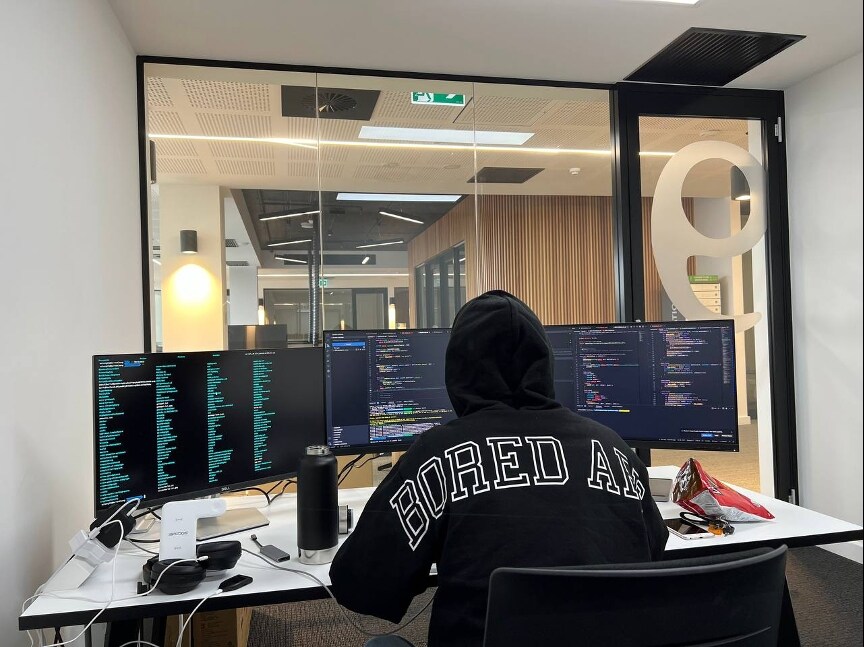
As for the price, he preferred to hand over the decision-making power to structure rather than emotion—“(Ethereum) is transparent and clear; Solana is relatively like a black box, where you can’t see anything… it feels more centralized.” “At least when I interact with each EVM, I can first check (the code/bytecode) myself and then decide whether to interact with it.”
This “structure-first” simple principle was not adhered to without regrets. During the most frenzied market conditions, he was also swept along by the tide. In 2021, he bought a BAYC for 35 ETH, and the floor price rose to 140 ETH, but he never sold. Because in crypto circles, as long as he showed the monkey avatar, someone would always come up to talk.
At the peak of the bull market—after the Otherside sale, he spent hundreds of ETH to buy Otherside containing Koda and Azuki. The turnaround was quicker than flipping a book; once “blue chips” rapidly collapsed, ultimately nearing zero.
“Later, I realized that using these material symbols to attract others wasn’t suitable for me.” As the bear market arrived, he almost cleared out his possessions, dragging only a suitcase as he became a digital nomad across Asia. Surprisingly, he began to enjoy the way of connecting solely through conversation and interaction—without boasting, without external aids, just the challenge of communication itself.
2022, Back to Australia, Bought the “ETH 10 K” License Plate
With LUNA and FTX facing issues one after another, he gradually withdrew client accounts: “Only running my own money.” During the most chaotic months, he flew to Australia to give himself a “youthful” explanation—a big house by the sea, a yard, a sports car, living close to the beach, watching the sea at dusk. He even pursued a master’s in IT for residency, thinking about “settling down in life.”
It was also then that he registered the “ETH 10 K” license plate in Perth—at that time, ETH was still around 3000 USD, and he intuitively felt that 10 K was “not far off,” treating this plate as a bet and a belief.
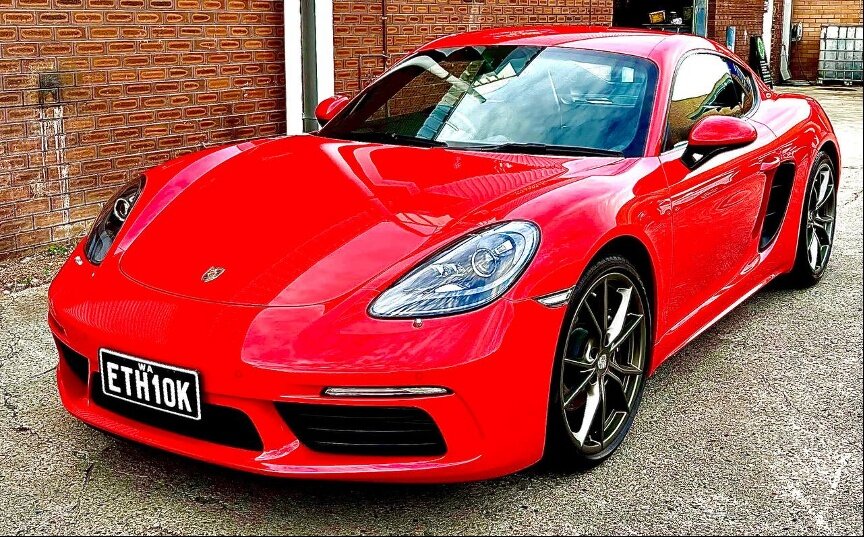
Reality quickly dulled the romance. In a house of over 300 square meters, he only visited one room in six months; of the three bathrooms, only one was frequently used. The sports car was hardly driven, and grocery shopping relied on an ordinary SUV. The sea breeze was pleasant during the day, but the nights felt empty—like a retirement town, with few people and sparse social interactions. He suddenly realized that the symbols he once thought were important—big houses, nice cars, sea views—did not provide meaning.
More pressing was the pressure from his trading system. The exchange API “went down” for seven minutes in the early morning; he was executing a funding rate strategy of “long spot, short futures,” which should have hedged each other—but during those seven minutes, a certain coin surged two to three times. At that time, there was no perfected cross margin, requiring manual transfers of spot profits to cover futures margins. When the API went down, the balance was lost, the futures leg was liquidated, and the spot leg fell again, incurring another loss. That time, three small clients’ accounts were wiped out, and he used his performance share for the month to fully compensate them.
He didn’t guarantee capital preservation, clearly explaining the risks, charging a 30% performance fee when making profits. For many traditional traders accustomed to “2% management fee + 20% commission,” this “only sharing profits when earning” approach felt more like binding both parties' interests together. But after the FTX collapse, he understood better: if my position was over there, it could very well go to zero. Coupled with API stability, counterparty risk, and the increasing number of times he was awakened at night, he made a decision—to return external funds and only run his own money.
2023—2025, Sold the Villa to Pick Apples, Dollar-Cost Averaged Ethereum; Bought Back the License Plate as Faith
Looking back, he truly made “long-term” commitments starting from that major drop. In 2022, Ethereum plummeted from 4871 to 880, and he watched the market, “When it was around 800 or 900, I did think about cutting losses, but in the end, I held on.” After that, he entrusted his decisions to discipline: starting dollar-cost averaging from around 1200, “buying more when it hit 1000, all the way to now. If it dropped by 50 USD, I treated it as a crash and added more.” With the other hand, he cleared away those things he thought would bring satisfaction—beachfront villa, sports car. He said during that time, “I felt very empty,” so he sold both the house and the car and went to a farm to pick apples. The more he sweated, the more settled his heart became: cash flow relied on strategy, and accumulation relied on dollar-cost averaging.
Starting in 2023, he completely cleared out external funds, only running his own accounts: still using that low-leverage, non-directional strategy; simultaneously taking on contract work, writing smart contracts/NFT contracts, settling on a “fixed fee + commission” basis. By 2025, this funding rate arbitrage program could still achieve about 10% annualized returns—“I thought I’d only play for three years, but unexpectedly, I’m still running in the fifth year.” He assessed, “It’s likely to be thinner going forward, but small volumes can still yield profits.” The method wasn’t flashy: verify what can be verified, gray test what can be rolled back, and don’t run naked on what can be hedged.
In the spring of 2025, he bought back the “ETH 10 K” license plate. It wasn’t for show; it felt more like a footnote for himself: the choices made during the bear market, he was still willing to sign off on today.
Why Ethereum? Seeking Assurance in Code
When Yuki asked him “why the license plate is Ethereum,” Wesley gave an engineer-like answer: because it can be verified.
His logic was straightforward—if a contract is non-upgradable, it will run according to the code on the chain, requiring no trust in anyone; in the EVM ecosystem, you can first look at the source code or bytecode before deciding whether to interact with it. “For an engineer like me, this is a sense of trust.”
He also talked about Solana: “It has strong performance, but after deployment, you can’t verify bytecode on-chain like EVM, which I personally find hard to grasp.” This wasn’t a denial but a preference: weighting in areas that are understandable and reproducible.
What about BTC? He respects its status as “digital gold” and acknowledges that BTC + ETH in a long-term portfolio is reasonable; but when it comes to his own position, he almost only buys ETH—“You could say it’s ‘professional bias.’ In my mind, Ethereum is more like an operating system such as iOS/Android.”
This summer, he got back the “ETH 10 K” license plate. As the interview wrapped up, he was set to fly to Bali and then transfer to Phu Quoc Island. Before leaving, he sent a message to a friend: “The moment the red taillights lit up, the clouds of the bear market were left behind in the rearview mirror.”
We returned to discussing “verifiability” and “risk constraints” in life: he likes cars and captures the red glow of their taillights; he also rolls back for a small bug at three in the morning. On the day ETH surged, the first thing he redeemed was the license plate—“It’s not vanity; it’s an account for my past self.”
He doesn’t urge people to “go all in,” but prefers to share “how to learn.” The simplest line goes like this: first, use Udemy’s Python Bootcamp to get the code running, then use O’Reilly’s Introducing Python (2nd) to fill in the basics and details, and finally take Coursera’s “Data Structures & Algorithms” specialization to solidify the underlying logic—first be able to do it, then understand why.
This interview belongs to the series for friends of OKX. What we care about is always the people who place technology and finance on the same table: the market will fluctuate, but methods must be verifiable. Wesley’s story is merely a footnote—low leverage, heavy auditing, verifiability are the underlying rules for traversing cycles.
If Ethereum 10,000 USD is destined to come, that “ETH 10 K” license plate will remind him first: drive slowly, don’t get carried away.
Disclaimer: This article is for reference only. It represents the author's views and does not reflect the position of OKX. This article does not intend to provide (i) investment advice or recommendations; (ii) offers or solicitations to buy, sell, or hold digital assets; (iii) financial, accounting, legal, or tax advice. We do not guarantee the accuracy, completeness, or usefulness of such information. Holding digital assets (including stablecoins and NFTs) involves high risks and may fluctuate significantly. You should carefully consider whether trading or holding digital assets is suitable for you based on your financial situation. Please consult your legal/tax/investment professionals regarding your specific circumstances. You are responsible for understanding and complying with applicable local laws and regulations.
免责声明:本文章仅代表作者个人观点,不代表本平台的立场和观点。本文章仅供信息分享,不构成对任何人的任何投资建议。用户与作者之间的任何争议,与本平台无关。如网页中刊载的文章或图片涉及侵权,请提供相关的权利证明和身份证明发送邮件到support@aicoin.com,本平台相关工作人员将会进行核查。

